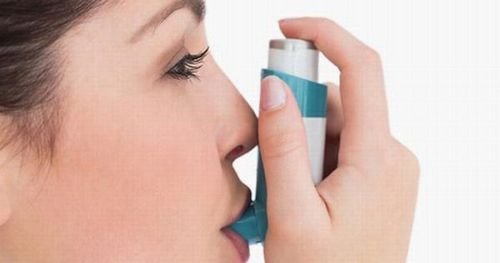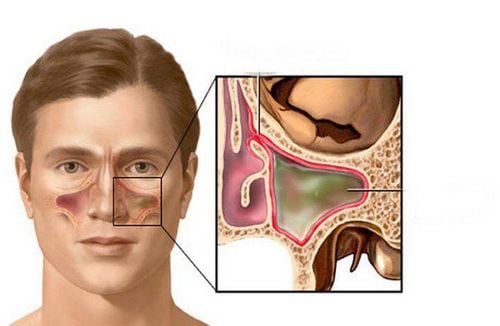This is an automatically translated article.
Allergic granulomatosis and vasculitis (Churg-Strauss syndrome) is a multisystem disorder characterized by allergic rhinitis, asthma, and eosinophilia.1. What is allergic granulomatosis and vasculitis?
Allergic granulomatosis and vasculitis (Churg-Strauss syndrome) is a disorder characterized by inflammation of the blood vessels. This restricts blood flow to tissues and organs, which can sometimes permanently damage blood vessels.Asthma is the most common sign of Churg-Strauss syndrome. The disease can also cause other problems, such as fever, rash, gastrointestinal bleeding, pain, and numbness in the hands and feet.
Allergic vasculitis and granulomatosis occur very rarely and currently there is no cure. Doctors can help patients manage symptoms with steroids and other immunosuppressive drugs.
2. Symptoms of disease
Symptoms of vasculitis and allergic granulomatosis are often very different. Some people have only mild symptoms, while others develop serious, even life-threatening complications.This syndrome tends to occur in 3 stages and gets progressively worse. Almost all patients had symptoms of asthma, chronic sinusitis, and elevated eosinophils. Asthma usually begins 5 to 9 years before the patient is diagnosed with allergic granulomatosis and vasculitis.
Other signs and symptoms may include:
Fever; Not eating well, losing weight; Joint and muscle pain; Tired; Cough; Abdominal pain, gastrointestinal bleeding; Feeling weak, exhausted, feeling unwell; skin rash or skin sores; Pain, numbness, tingling in the hands and feet; Severe abdominal pain; Shortness of breath ; There is blood in the urine or stools.

Hầu như tất cả bệnh nhân đều có triệu chứng hen suyễn, viêm xoang mãn tính
3. Causes of vasculitis and allergic granulomatosis
The cause of Churg-Strauss syndrome is largely unknown. However, it is hypothesized that the condition is genetic and that environmental factors, such as exposure to allergens or certain medications, trigger an immune response. Instead of defending the body against invading bacteria and viruses, the immune system targets healthy tissue, causing widespread inflammation.4. Who is susceptible to the disease?
There is a high risk of Churg-Strauss syndrome occurring in the following people:Average age: Most people with vasculitis and allergic granulomatosis are diagnosed between the ages of 30 and 50; Have a history of asthma or other nasal problems. Most people diagnosed with Churg-Strauss syndrome have a history of allergic rhinitis, chronic sinusitis, or severe asthma.
5. Complications of Churg-Strauss
Churg-Strauss syndrome can affect many organs, including the lungs, skin, digestive system, kidneys, muscles, joints, and heart. If left untreated, the disease can be fatal.Complications occur depending on the organs involved, including:
Peripheral nerve damage: Affects the nerves in the patient's arms and legs, leading to numbness, heat, and loss of function ; Skin scarring: Inflammation can cause sores on the skin, leaving scars; Heart disease: Heart-related complications of Churg-Strauss syndrome include pericarditis, inflammation of the muscular layer of the heart wall, heart attack, and heart failure; Nephrotic syndrome: When allergic granulomas affect the kidneys, a person can develop glomerulonephritis. This condition interferes with the kidneys' ability to filter, leading to a buildup of waste products in the blood that are not filtered by the kidneys.

Biến chứng tim mạch là một trong nhiều biến chứng của hội chứng Churg - Strauss
6. Diagnosis of allergic granulomatosis and vasculitis
There is currently no test that can accurately diagnose Churg-Strauss syndrome. This is because the signs and symptoms of allergic multiple granulomatosis and vasculitis are similar to those of other diseases, making an accurate diagnosis difficult.Early signs and symptoms of illness, such as asthma and sinusitis, are often quite common. As a result, Churg-Strauss syndrome often goes undetected until inflammation causes severe damage to organs and nerves.
To diagnose the disease, the doctor may order a number of tests, including:
Blood tests: To detect certain antibodies in the patient's blood, measure the number of eosinophils; Imaging tests (including X-rays and CT scans): Look for abnormalities in the lungs and sinuses; Tissue biopsy: If tests show that you are at risk for Churg-Strauss syndrome, your doctor will take a small sample of tissue to examine under a microscope. Tissue may be taken from the lung or another organ, such as skin or muscle, to assist in identifying or ruling out the possibility of vasculitis and allergic granulomatosis.
7. Treatment of Churg-Strauss syndrome
To date, there is no cure for allergic granulomatosis and vasculitis. However, a number of medications are effective in controlling symptoms, including:Corticosteroids: They work to reduce inflammation and are the most commonly prescribed drugs for Churg-Strauss syndrome; Immunosuppressive agents: For those with mild symptoms, corticosteroids alone are sufficient. However, for more severe symptoms, another immunosuppressive drug, such as cyclophosphamide, azathioprine or methotrexate, should be combined with another immunosuppressant to suppress the body's immune response, thereby reducing symptoms. ; Immunoglobulin: Given as an injection, immunoglobulin is often used for people who have not responded to other treatments; Biologics: Mepolizumab (brand name Nucala), benralizumab (Fasenra), and rituximab (Rituxan) have been FDA-approved for use in altering the immune system response, improving symptoms, and lowering white blood cell counts. craving. Drug therapy has the potential to improve symptoms of allergic granulomatosis and vasculitis. However, relapses are very common.
The doctor will regularly conduct blood tests and some other necessary tests to monitor the patient's condition and response to the drugs being used.
8. Lifestyle and home remedies

Bỏ thuốc lá để hạn chế một số tác dụng phụ không mong muốn của thuốc điều trị bệnh
Protect their bones: Talk to your doctor about whether you should add vitamin D and calcium to your daily diet and at what dosage how many, how much; Exercise: Helps you maintain and stabilize your weight. This is important for patients taking corticosteroid medications because of the side effects of weight gain. Working out with exercises like walking and jogging also improves bone health; Quit smoking: The harm from tobacco can cause serious health problems, while also worsening the condition and increasing the side effects of the drug; Build a healthy diet: Steroids can cause high blood sugar and the risk of type 2 diabetes. A reasonable diet, prioritizing fruits, vegetables and whole grains. , will help stabilize blood sugar. Patients should be provided with adequate knowledge of allergic granulomatosis and vasculitis in order to understand and prepare early countermeasures for complications and risk of recurrence.
Please dial HOTLINE for more information or register for an appointment HERE. Download MyVinmec app to make appointments faster and to manage your bookings easily.
Reference source: Mayoclinic.org












